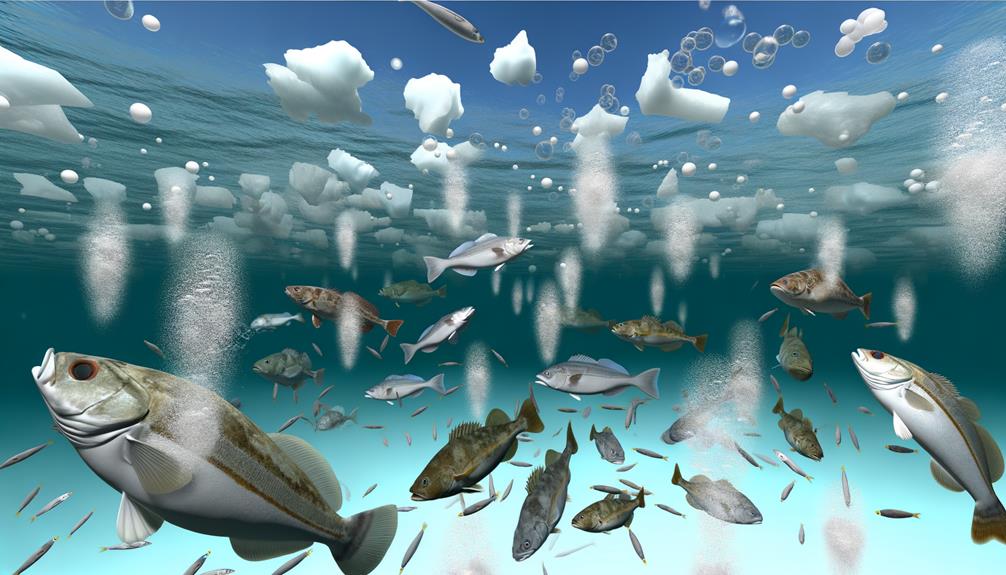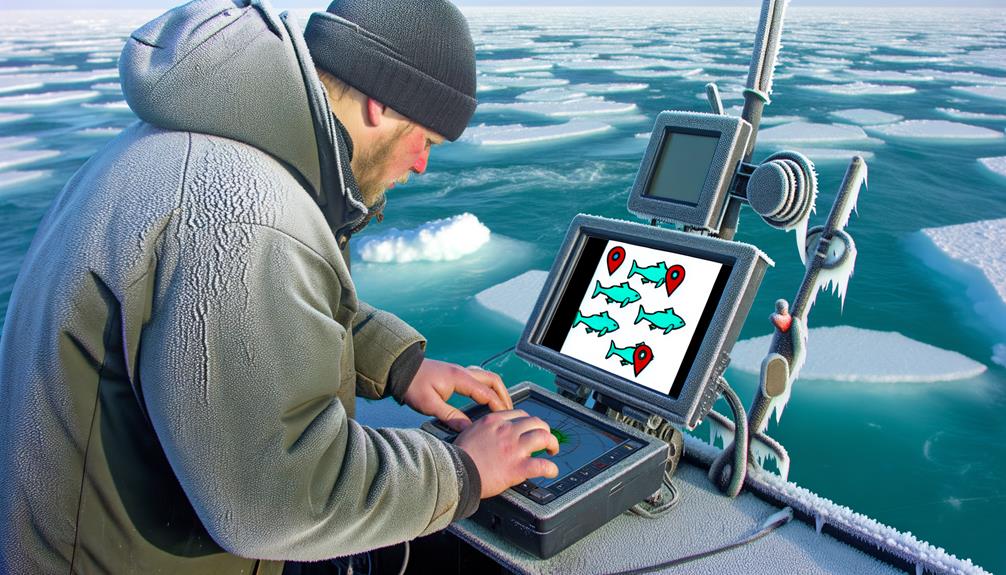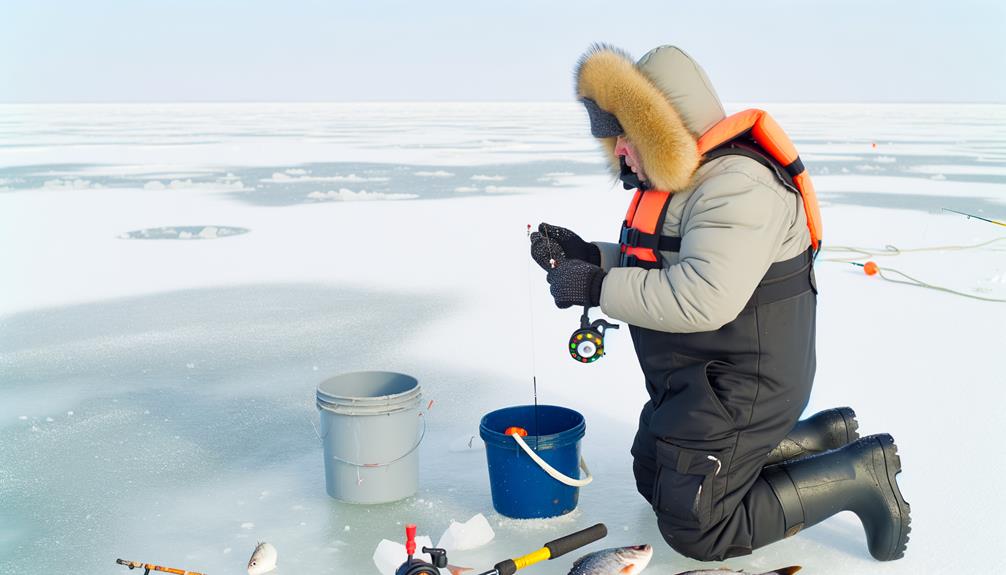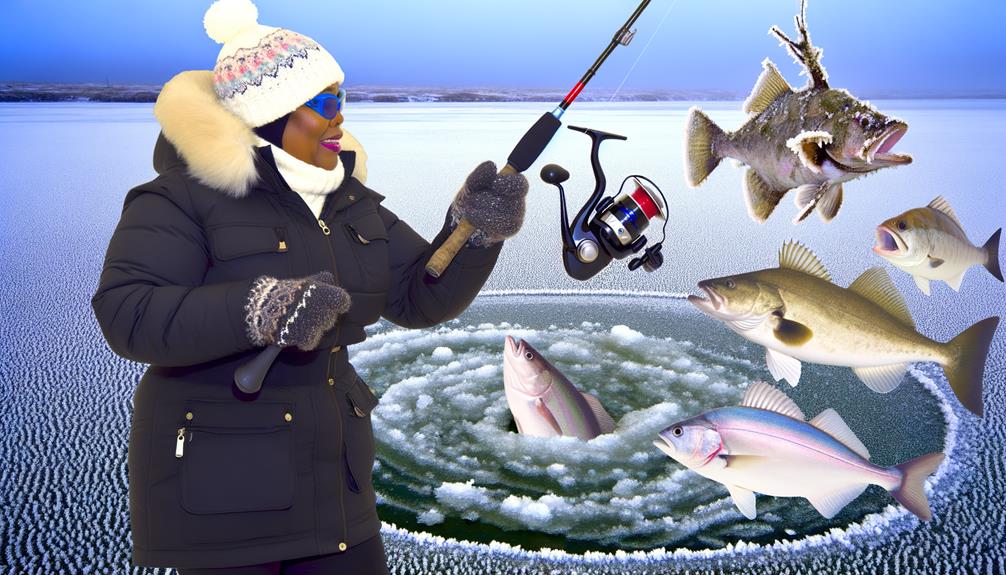The impact of cold weather on the feeding habits of saltwater fish is a topic that has intrigued many an angler.
While it's common knowledge that fish are cold-blooded creatures and their activity levels can be influenced by changes in temperature, the extent to which these changes affect their propensity to bite in colder weather remains a subject of ongoing discussion and research.
Thus, cultivating a more comprehensive understanding of how to maximize one's success in saltwater fishing during cold weather conditions is an endeavor that may hold significant benefits for both amateur and seasoned anglers alike.
Key Takeaways
- Saltwater fish adapt to cold weather, with species like redfish and sheepshead remaining active and offering fishing opportunities.
- Cold weather triggers changes in fish behavior, including a shift towards deeper waters and altered feeding patterns.
- Understanding fish behavior, environmental conditions, and suitable fishing techniques is crucial for successful winter fishing.
- Fish seek warmer waters in winter, making muddy bottoms and shell-littered areas key locations to find baitfish and game fish.
Understanding Saltwater Fish Behavior
In navigating the complex behavior of saltwater fish during cold weather, one must consider an array of factors including species differentiation, environmental conditions, and the need to adjust fishing techniques. The variance in saltwater fish behavior during colder months is largely influenced by species-specific characteristics and responses to water temperatures. Some species become lethargic in frigid waters, necessitating a slower presentation of lures to entice a bite.
Understanding how these behavioral shifts affect fish movement and feeding patterns is integral to successful Winter Fishing. Lowered temperatures, for instance, can lead to certain species congregating in warmer water pockets or areas abundant in food sources. This clustering behavior may provide an opportunity for anglers to capitalize on concentrated fish populations.
Adaptation to these changing conditions is paramount. Employing suitable lures and techniques tailored to the behavior of the targeted species and the prevailing environmental conditions could enhance the likelihood of a successful catch. In essence, a deep understanding of saltwater fish behavior during cold weather, coupled with the ability to adapt and apply appropriate fishing techniques, is key to effective Winter Fishing.
Impact of Cold Weather on Fish
Building on the understanding of saltwater fish behavior in cold weather, it becomes crucial to examine the specific impacts of such conditions on various fish species. A cold front can trigger a significant shift in fish behavior. They tend to gravitate towards deeper water as it remains warmer and provides a refuge from the harsh conditions at the surface.
The metabolic rate of fish slows down in cold weather, leading to reduced activity levels and altered feeding patterns. Despite this, certain species such as redfish and trout exhibit increased activity, presenting opportunities for the discerning angler.
Understanding these shifts in movement and feeding habits in cold weather is essential for successful winter fishing. Below is a table illustrating some of the changes in fish behavior during a cold front:
| Fish Behavior | Impact of Cold Weather |
|---|---|
| Activity levels | Decrease due to slowed metabolism |
| Feeding patterns | Altered; some species feed more |
| Movement | Tendency to seek deeper water |
| Species-specific behavior | Some species like redfish, trout become more active |
| Fishing prospects | Opportunities present for dedicated anglers |
Thus, the impact of cold weather on fish behavior provides a unique challenge and opportunity for anglers.
Top Saltwater Fish Species in Cold Weather

In the colder climes, certain species of saltwater fish exhibit remarkable adaptability, rendering them active and capable of survival.
This segment will explore these cold-weather saltwater species, their unique cold survival adaptations, as well as their preferred prey and bait during these conditions.
Understanding these dynamics not only offers insights into their behavior and survival mechanisms, but also provides practical knowledge for angling enthusiasts seeking success in winter fishing.
Cold-Weather Saltwater Species
Several saltwater fish species exhibit unique adaptations that enable them to thrive in colder weather, offering a variety of options for winter fishing enthusiasts.
One such species is the Sheepshead, which sustains its diet with crabs and shrimp, providing a lucrative substitute for other fish during the cold weather.
Redfish, the official saltwater species of North Carolina, also remain active in chilly temperatures, particularly in shallow flats.
Similarly, Bonefish, operating in flats, demand accurate casts and stealthy approaches, offering a challenging fishing experience in the wintry conditions.
Striped Bass and Snapper, found in southern regions and shallow spots respectively, offer plentiful opportunities for fishing in cold weather, ensuring a rewarding experience for winter anglers.
Cold Survival Adaptations
Adapting to varying temperature extremes, top saltwater fish species such as Redfish, Speckled trout, Sheepshead, Snook, and Black drum exhibit remarkable cold survival mechanisms that allow them to remain active during winter.
Redfish, notably resilient, adjust their metabolic processes to accommodate the cold, maintaining their activity level. Similarly, Speckled trout, a sought-after cold-water game fish, demonstrate a high tolerance for cold temperatures due to their efficient thermo-regulatory systems.
Sheepshead, with their specialized dentition, adapt to colder climates through their versatile feeding habits. Snook, another popular game fish, counter cold conditions by seeking warmer pockets or moving to deeper waters, effectively conserving energy. Black drum, appreciated for their hardiness, adapt effectively to cold weather, ensuring continued survival and availability for fishing.
Preferred Prey and Bait
Understanding the preferred prey and bait of top saltwater fish species during cold weather can significantly enhance the success of winter fishing endeavors.
For instance, redfish and trout primarily feed on mullet in colder water temperatures. Additionally, sheepshead have a preference for crabs and shrimp, making them a viable target in winter.
Redfish remain active in shallow flats, notably on sunny winter days, while cobia, a winter-active feeder, is responsive to various lures.
Snapper, on the other hand, migrate to shallower water spots during winter, rendering them accessible for smaller fishing vessels.
Recognizing these prey preferences and adapting your bait selection can decisively improve your cold weather fishing outcomes.
Navigating Fish Locations in Winter

In the winter months, it becomes critical for anglers to accurately identify and navigate to locations where fish are likely to congregate, as these creatures instinctively seek out warmer waters and navigate between deep and shallow waters based on temperature changes. This behavior typically makes muddy bottoms and shell-littered areas attractive spots for both baitfish and game fish.
After cold fronts, water clarity can create calm environments, while murkier waters in bays provide cover, making these locations ideal for fishing. Transitional areas with mud and shell bottoms become particularly significant, as fish transition from deeper waters to shallower ones with the changing temperatures.
Moreover, intracoastal waterways and flats become prime locations for finding fish in winter, with deeper waters preferred immediately after winter fronts. Additionally, understanding the tidal movement is crucial in winter fishing. Falling tides can lead to finding fish in cuts and drains, while windward shorelines attract fish due to bait movement.
Essential Winter Fishing Gear
When embarking on winter fishing expeditions, the importance of specialized gear cannot be overstated. Insulating cold weather outfits, reliable fishing equipment, and the necessity of survival tools form the triad of essentials for such endeavors.
Each component serves a critical role in ensuring the angler's comfort, safety, and success during fishing in cold weather.
Insulating Cold Weather Outfits
Braving the harsh winter conditions for saltwater fishing necessitates the use of insulating cold weather outfits, a critical component of which is the strategic layering of clothing to effectively trap body heat. This scientific and analytical approach is key to staying warm and comfortable throughout your fishing expedition.
Here are essential items to consider:
- Base layers made from wool or synthetic fabrics for optimal heat retention.
- Middle layers of fleece to provide additional insulation.
- Waterproof and windproof outer layers to shield from moisture and wind.
- Insulated hats, gloves, boots, and socks for comprehensive warmth.
These detailed insights into the building blocks of cold weather attire offer a profound understanding of how to ensure a successful and enjoyable saltwater fishing experience, irrespective of the winter conditions.
Reliable Fishing Equipment
Equipped with the right attire for harsh winter conditions, it becomes equally imperative to focus on the selection of reliable fishing equipment, a cornerstone of successful winter fishing endeavors. The right gear such as MirrOlures, Paul Brown Corky, Power Prawn, Slam Shady 2.0, and Gold Digger Paddletail can significantly enhance the success of your cold weather fishing expeditions.
Below is a table summarizing essential winter fishing gear:
| Type | Example | Benefit |
|---|---|---|
| Lures | MirrOlures, Power Prawn | Effective in cold waters |
| Twitchbait | Paul Brown Corky | Alters for better performance |
| Positioning tools | Power Pole, Stake-Out Stick | Improve boat positioning |
Consideration of these tools can elevate your angling experience, ensuring a productive venture despite the chill. Proper selection is crucial to overcoming the challenges of winter fishing.
Necessity of Survival Tools
In the realm of cold weather fishing, the inclusion of survival tools such as life jackets and signaling devices becomes indispensable for ensuring safety and preparedness in the face of potential emergencies. As the water gets cold, the challenges of catching fish increase, necessitating additional precautions.
Key survival tools include:
- Suspender style Personal Floatation Devices (PFDs): These offer comfort, ease of use, and heightened safety.
- Whistles: These signaling devices carry sound farther than voices, and are critical in attracting attention during emergencies.
- Headlamps: Providing hands-free illumination, these are essential when fishing in darker, colder months.
- Hand warmers: These can prevent hypothermia, ensuring you can operate your gear effectively.
In essence, the right tools significantly elevate your ability to respond to emergencies, thereby enhancing your overall fishing experience.
Effective Winter Fishing Techniques
Often during the colder seasons, anglers must adapt their fishing methods given the altered behavior of fish, particularly in targeting areas with mud and shell bottoms and slowing down lure retrieval. During winter months, cold fronts may result in an observable shift in fish activity, making it essential for anglers to understand and respond accordingly to these changes.
The successful winter angler adapts tactics to mimic the dietary preferences of key species during cold weather, such as redfish and trout. With mullets serving as a primary food source in these species' ecosystem, the use of mullet imitations becomes an effective strategy. By working these lures close to the muddy and shell-bottomed areas, anglers can increase their chances of attracting fish in these habitats.
Moreover, a comprehensive understanding of tidal movements and wind patterns, in conjunction with fish behavior, can significantly enhance the fishing experience. These elements dictate the location and concentration of fish, hence their consideration leads to an effective winter fishing strategy. Thus, the modification of fishing tactics in response to environmental variables is vital during the winter months, ensuring success amidst the challenges posed by cold fronts.
Safety Measures for Winter Fishing

Navigating the precarious waters of winter fishing necessitates the implementation of specific safety measures to protect against the harsh conditions and potential emergencies. The low temperatures, coupled with the potential for rapid weather changes, can create an environment fraught with risk. As such, the adoption of safety precautions is paramount for any winter fishing expedition.
Critical safety measures include:
- Proper attire: Foul weather gear is essential to maintain comfort and protection, mitigating the risks associated with cold exposure, such as hypothermia.
- Life jackets: These are non-negotiable, particularly in rough sea conditions. The advent of new, less bulky designs promotes greater compliance.
- Emergency preparedness: Understanding how to respond to potential emergencies, like boat malfunctions, is a fundamental part of winter fishing safety.
- Awareness of water temperature: This can inform the selection of appropriate gear and precautions.
These considerations ensure a safe and enjoyable winter fishing experience. By adhering to such guidelines, we not only protect ourselves but also help to foster a collective culture of safety and responsibility within our angling community.
Common Winter Fishing Misconceptions
Contrary to popular belief, fish exhibit heightened activity levels during cold weather, driven significantly by an increase in their metabolic rate. This provides a stark contrast to the common misconception that fish become dormant or sluggish in winter. While it's true that fish behavior alters in response to temperature shifts, colder conditions do not necessarily induce a state of inactivity. In fact, certain species like redfish and trout are known to thrive in such conditions.
A prevailing winter fishing fallacy is that it yields smaller catches. Yet, the reality is that trophy-sized fish are often caught during the colder months. The amplified metabolic rate in fish due to cold weather increases their feeding activity, leading to potential larger catches for winter anglers.
Understanding these misconceptions is crucial for anyone looking to engage in winter fishing. Acknowledging the actual behavior of fish in cold weather can significantly improve fishing success. Consequently, it is essential for the fishing community to dispel these myths, encouraging a more informed, inclusive, and successful winter fishing experience.
Expert Tips for Successful Winter Fishing

Building on the understanding of winter fish behavior, let's explore some expert strategies for successful cold weather fishing, focusing on tactics such as slow lure retrieval, observation of baitfish activity, and finding warm waters.
To ensure a rewarding fishing experience, meticulous preparation and strategic planning are crucial. Here are some scientifically-backed strategies:
- Slow lure retrieval: In colder temperatures, fish metabolism slows down, making them less active. Slow lure retrieval mimics the slower movements of natural prey, making it more tempting to fish.
- Observation of baitfish activity: Baitfish tend to congregate in warmer waters during winter. Observing their patterns can lead you to active fish.
- Finding warm waters: Fish are cold-blooded creatures that seek warmer waters in winter for survival. Mapping warm water areas can enhance your chances.
- Dressing in layers: With sudden weather changes, dressing in layers can help maintain body warmth, ensuring a comfortable fishing experience.
These scientifically-tested strategies, when combined with patience and observation, can help you belong to the esteemed group of successful winter anglers. Remember, understanding the behavior of your target fish is key to a successful fishing excursion, regardless of the season.
Frequently Asked Questions
Is Saltwater Fishing Good in Cold Weather?
Yes, saltwater fishing can be productive in cold weather. Success hinges on appropriate cold weather gear, strategic tackle adjustments, and knowledge of species-specific behaviors. It fosters a sense of belonging among those braving the elements together.
Which Fish Bite Best in Cold Weather?
Cold adaptation strategies enable certain saltwater fish, such as redfish, sheepshead, snook, trout, cobia, barracuda, striped bass, and bonefish to remain active in cold weather. Seasonal fishing tactics increase success in catching these species.
Do Fish Still Bite When Its Cold?
Yes, fish do bite in cold weather, albeit less actively due to slowed metabolism from temperature impacts. Adapting fishing strategies and employing cold weather fishing gear can enhance success during these chillier periods.
Will Fish Bite in 40 Degree Weather?
Water temperature significantly influences fish behavior. In 40-degree weather, fish metabolism slows down, making them less active. However, with the right techniques and locations, these fish can still be enticed to bite.
Conclusion
In conclusion, cold weather indeed impacts saltwater fish behavior, but does not entirely halt their feeding activities. Successfully enticing a bite during colder periods is akin to solving a complex puzzle, requiring an in-depth understanding of fish species, their movement patterns, and winter fishing techniques.
Equipped with the right gear and knowledge, an angler can turn the stark winter seascape into a rewarding fishing ground, debunking common misconceptions about winter fishing.


